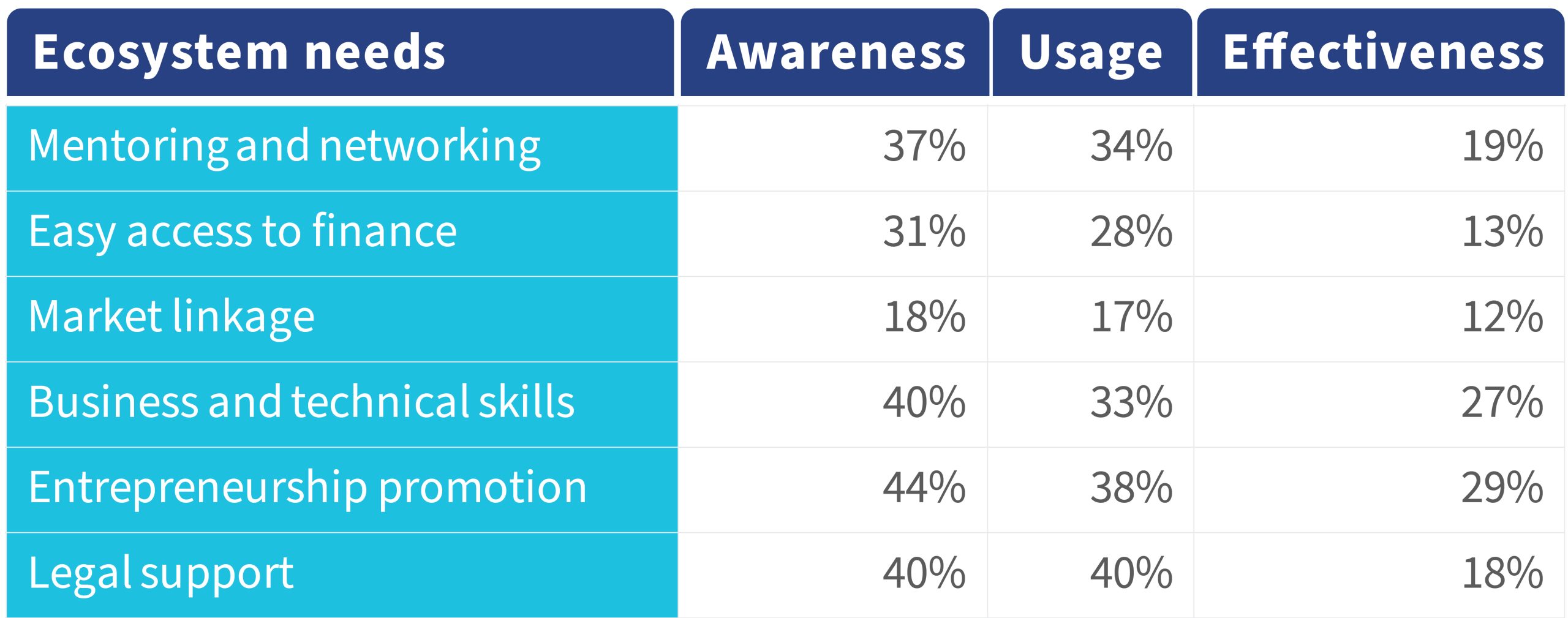From surviving to thriving: How stakeholders can meet the unmet needs of Bangladesh’s women entrepreneurs
 by Ayushi Misra, Sadia Shahnaz and Kunal Sharma
by Ayushi Misra, Sadia Shahnaz and Kunal Sharma Feb 13, 2025
Feb 13, 2025 4 min
4 min
Women entrepreneurs in Bangladesh face systemic barriers such as limited financial access, inadequate mentorship, and weak market linkages, despite their confidence and skills. A study using MSC’s Ecosystem Needs Framework found that awareness and effectiveness of support programs remain low, hindering business growth. Only 1% of women entrepreneurs have all six critical ecosystem needs met. Addressing these gaps through gender-sensitive policies, financial inclusion, and targeted mentorship can unlock their potential, fostering inclusive economic development.
In the first part of this blog series, we highlighted how female entrepreneurs exhibit the same confidence, capability, and drive as their male counterparts to challenge stereotypes and demonstrate their potential. This blog highlights that systemic barriers that emerge from poor support programs impede their progress, such as limited financial access, lack of mentorship, and insufficient market linkages.
Women entrepreneurs in Bangladesh and elsewhere worldwide grapple with persistent gender-based challenges in their daily lives. Yet they exhibit strong confidence, business management skills, and determination through which they can drive growth, provided they receive the right support. As discussed in the earlier blog in this series, both genders share similar confidence levels, business practices, and aspirations. However, women face systemic barriers that hinder their ability to compete on equal terms and hold back their potential to thrive.
We conducted a study in Bangladesh to understand how these challenges are being addressed at the ecosystem level. Through the study, we assessed how policymakers and other stakeholders meet the critical support needs of women entrepreneurs. We used MSC’s Ecosystem Needs Framework and insights from the Women Business Diaries project to explore six key areas of the entrepreneurial ecosystem:
- Entrepreneurship promotion
- Access to finance
- Business and technical skills
- Mentoring and networking
- Market linkages
- Legal support
We further evaluated each of these ecosystem components based on three key parameters:
Awareness: Is the business owner aware of any initiatives related to these ecosystem needs?
Usage: If the business owner is aware, did they use the service or benefit from the initiative?
Effectiveness: If the business owner used the service or availed of the initiative, how effective did they find it?
The table below summarizes our findings. It illustrates the proportion of women entrepreneurs whose needs are being met across these six ecosystem components based on the three parameters.

Additionally, the research also highlighted that
- Business owners whose ecosystem needs are met are more likely to engage in growth-oriented actions, while those with unmet needs report lower levels of such activity.
- Business owners with more ecosystem needs fulfilled experience higher sales and profits.
- However, only 1% of female business owners have all six needs fully met.
The findings are not encouraging. For almost all ecosystem needs, less than 50% of business owners had access to any government or private sector program. These numbers are even lower on effectiveness, which indicates that the programs’ design does not match the gaps. Our discussions reveal that many women rely on informal networks, for funds, such as family and friends, who may lack the expertise to help navigate business challenges.
A major barrier for women entrepreneurs in Bangladesh is a lack of awareness of available support programs. Despite various government and NGO-led initiatives, many women remain in the dark about the resources that could help them access finance, mentorship, and market linkages—all essential for growth. For example, the Women Entrepreneurship Development Unit (WEDU) at the Bangladesh Bank seeks to enhance access to finance through specialized financial products, training, and mentorship for women entrepreneurs. Yet, only a handful of the respondents knew of the programs that lead banks offered through the WEDU.
Similarly, despite the existence of market linkage programs, such as Women and E-commerce, and NGOs, such as the SME Foundation and Joyeeta, only two in 10 respondents knew about any market linkage programs. Their low awareness levels limit the use of such initiatives. However, the trends indicate that most women who are aware of such programs use them.
More worrisome is the fact that less than 20% of respondents find most programs effective, which underscores significant challenges in program design. Findings from qualitative discussions revealed that these initiatives often fail to accommodate the needs of women, which makes it difficult for them to attend the sessions or benefit from them.
Key barriers include inconvenient scheduling, irrelevant or overly generic content, limited opportunities for participant feedback, and a lack of sensitivity from trainers. Such shortcomings reveal a critical gap: Many programs are not developed through a gender-sensitive lens. This oversight limits their ability to address systemic inequities or empower women effectively.
Many would expect “Ease of access to finance” to be viewed more positively than the other enablers. Yet, our discussions highlighted how women faced under-financing; delays in disbursement; difficult and exclusionary terms and conditions; minimal options for tenure, grace period, and other key terms; and high interest rates—particularly from microfinance institutions. All these challenges were amplified by women’s self-reported poor financial management skills, which meant they struggled to deploy the proceeds effectively even when they could access funds.
Stakeholders, including donors, policymakers, and practitioners, can drive meaningful impact by designing programs that meet the ecosystem’s needs. They can address these needs of women to significantly enhance their business potential—whether through improved access to finance, mentorship, or tailored policies. If stakeholders focus on creating programs and systems that fill such gaps, they would unlock substantial positive outcomes and create a pathway to achieve lasting, scalable impact and promote inclusive development.
As a result, these programs can empower more women-led businesses to expand their ventures, generate economic growth in local communities, and contribute to the broader national economy. Through such tailored support, Bangladesh’s women entrepreneurs can give flight to their dreams and, in the process, enrich their families, communities, and the nation.



Leave comments